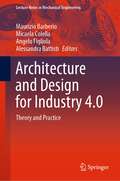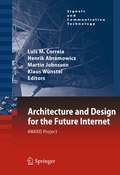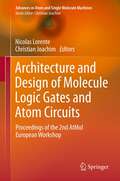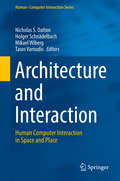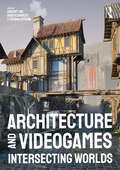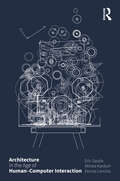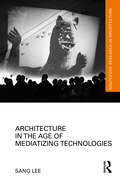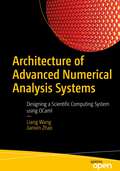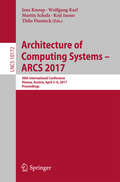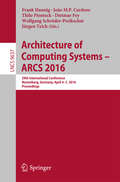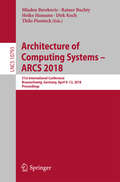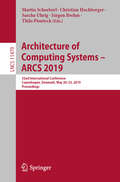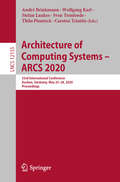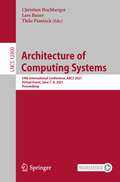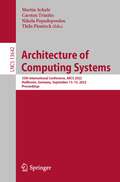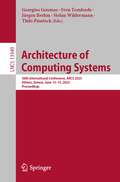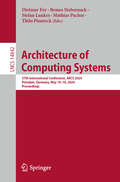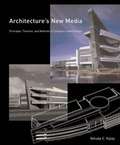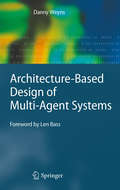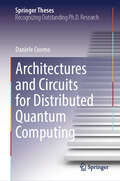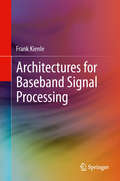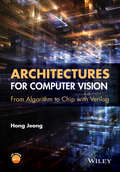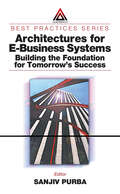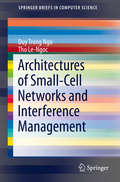- Table View
- List View
Architecture and Design for Industry 4.0: Theory and Practice (Lecture Notes in Mechanical Engineering)
by Angelo Figliola Alessandra Battisti Maurizio Barberio Micaela ColellaThis book collects contributions of forefront research and practices related to the use of the enabling technologies of Industry 4.0 in the architecture and design fields and their impact on the UN's Sustainable Developments goals. The book is structured into three sections (research, practice, and technologies), with the goal of creating a new framework useful for widespread awareness necessary to initiate technology transfer processes for the benefit of the public sector, universities, research centers, and innovative companies, and a new professional figure capable of controlling the entire process is essential. Thus, the book chapters arouse a series of relevant topics such as computational and parametric design, performance-based architecture, data-driven design strategies, parametric environmental design and analysis, computational and parametric structural design and analysis, AI and machine learning, BIM and interoperability, VR and AR, digital and robotic fabrication, additive manufacturing and 3D printing, R&D and entrepreneurship, circular architecture, and didactics. In the post-digital era, where the essence of design lies in the control and information of the process that holistically involves all the aspects mentioned above, rather than in formal research, it is necessary to understand technologies and analyze the advantages that they can bring in terms of environmental sustainability and product innovation.
Architecture and Design for the Future Internet: 4WARD Project (Signals and Communication Technology)
by Luis M. Correia Klaus Wünstel Henrik Abramowicz Martin JohnssonArchitecture and Design for the Future Internet addresses the Networks of the Future and the Future Internet, focusing on networks aspects, offering both technical and non-technical perspectives. It presents the main findings of 4WARD (Architecture and Design for the Future Internet), a European Integrated Project within Framework Programme 7, which addressed this area from an innovative approach. Today's network architectures are stifling innovation, restricting it mostly to the application level, while the need for structural change is increasingly evident. The absence of adequate facilities to design, optimise and interoperate new networks currently forces a convergence to an architecture that is suboptimal for many applications and that cannot support innovations within itself, the Internet. 4WARD overcomes this impasse through a set of radical architectural approaches, built on a strong mobile and wireless background. The main topics addressed by the book are: the improved ability to design inter-operable and complementary families of network architectures; the enabled co-existence of multiple networks on common platforms through carrier-grade virtualisation for networking resources; the enhanced utility of networks by making them self-managing; the increased robustness and efficiency of networks by leveraging diversity; and the improved application support by a new information-centric paradigm in place of the old host-centric approach. These solutions embrace the full range of technologies, from fibre backbones to wireless and sensor networks.
Architecture and Design of Molecule Logic Gates and Atom Circuits: Proceedings of the 2nd AtMol European Workshop (Advances in Atom and Single Molecule Machines)
by Christian Joachim Nicolas LorenteHave you ever puzzled over how to perform Boolean logic at the atomic scale? Or wondered how you can carry out more general calculations in one single molecule or using a surface dangling bond atomic scale circuit? This volume gives you an update on the design of single molecule devices, such as recitfiers, switches and transistors, more advanced semi-classical and quantum boolean gates integrated in a single molecule or constructed atom by atom on a passivated semi-conductor surface and describes their interconnections with adapted nano-scale wiring. The main contributors to the field of single molecule logic gates and surface dangling bond atomic scale circuits theory and design, were brought together for the first time to contribute on topics such as molecule circuits, surface dangling bond circuits, quantum controlled logic gates and molecular qubits. Contributions in this volume originate from the Barcelona workshop of the AtMol conference series, held from January 12-13 2012.
Architecture and Interaction: Human Computer Interaction in Space and Place (Human–Computer Interaction Series #0)
by Mikael Wiberg Nicholas S. Dalton Holger Schnädelbach Tasos VaroudisUbiquitouscomputing has a vision of information and interaction being embedded in theworld around us; this forms the basis of this book. Built environments aresubjects of design and architects have seen digital elements incorporated intothe fabric of buildings as a way of creating environments that meet the dynamicchallenges of future habitation. Methods forprototyping interactive buildings are discussed and the theoretical overlapsbetween both domains are explored. Topics like the role of space and technologywithin the workplace as well as the role of embodiment in understanding howbuildings and technology can influence action are discussed, as well as investigating the creation of place with new methodologies toinvestigate the occupation of buildings and how they can be used to understandspatial technologies. Architectureand Interaction is aimed at researchers and practitioners in the field of computing who want togain a greater insight into the challenges of creating technologies in thebuilt environment and those from the architectural and urban design disciplineswho wish to incorporate digital information technologies in future buildings.
Architecture and Principles of Systems Engineering (Complex and Enterprise Systems Engineering)
by Charles Dickerson Dimitri N. MavrisThe rapid evolution of technical capabilities in the systems engineering (SE) community requires constant clarification of how to answer the following questions: What is Systems Architecture? How does it relate to Systems Engineering? What is the role of a Systems Architect? How should Systems Architecture be practiced?A perpetual reassessment of concepts and practices is taking place across various systems disciplines at every level in the SE community. Architecture and Principles of Systems Engineering addresses these integral issues and prepares you for changes that will be occurring for years to come. With their simplified discussion of SE, the authors avoid an overly broad analysis of concepts and terminology. Applying their substantial experience in the academic, government, and commercial R&D sectors, this book is organized into detailed sections on: Foundations of Architecture and Systems Engineering Modeling Languages, Frameworks, and Graphical Tools Using Architecture Models in Systems Analysis and Design Aerospace and Defense Systems Engineering Describing ways to improve methods of reasoning and thinking about architecture and systems, the text integrates concepts, standards, and terminologies that embody emerging model-based approaches but remain rooted in the long-standing practices of engineering, science, and mathematics. With an emphasis on maintaining conceptual integrity in system design, this text describes succinct practical approaches that can be applied to the vast array of issues that readers must resolve on a regular basis. An exploration of the important questions above, this book presents the authors’ invaluable experience and insights regarding the path to the future, based on what they have seen work through the power of model-based approaches to architecture and systems engineering.
Architecture and Videogames: Intersecting Worlds
by Vincent Hui Ryan Scavnicky Tatiana EstrinaThis book explores and affirms the emergent symbiosis between videogames and architecture, including insights from a diverse range of disciplines.With contributions from authorities in both architecture and videogame industries, it examines how videogames as a medium have enlightened the public about the built environments of the past, offered heightened awareness of our current urban context, and presented inspiration for the future directions of architecture. A relatively nascent medium, videogames have rapidly transitioned from cultural novelty to architectural prophet over the past 50 years. That videogames serve as an interactive proxy for the real world is merely a gateway into just how pervasive and potent the medium is in architectural praxis. If architecture is a synthesis of cultural value and videogames are a dominant cultural medium of today, how will they influence the architecture of tomorrow?The book is split into seven sections: Cultural Artifacts, Historic Reproduction, Production Technologies, Design Pedagogy, Proxies and Representation, Bridging Worlds, and Projected Futures.
Architecture in the Age of Human–Computer Interaction
by Eric Sauda Alireza Karduni Donna LanclosThis book investigates the spaces where architecture and computer science share a common set of assumptions and goals, using methods and objectives from architecture, ethnography, and human–computer interaction (HCI).Architecture and HCI depend on and borrow from each other, and even share some vocabulary in their divergent disciplinary agendas. The authors here unpack the past, present, and potential futures of architecture and the user interface, employing the lens of ethnography and ethnographic practices to launch this exciting cross-disciplinary inquiry. The goal is the creation of an interface that is able to connect the wide range of embodied architectural space, the modes of interaction afforded by computation, and the social process of creating meaningful places.This will be of great interest to upper-level students and academics in the fields of architecture, human–computer interaction, and ethnography.
Architecture in the Age of Mediatizing Technologies (Routledge Research in Architecture)
by Sang LeeThis book offers a novel perspective on contemporary architecture, exploring its position in mediatization, attained through technological apparatuses. It introduces the novel concepts of apparatus-centricity and mediatization of architecture, which have significant disciplinary and cultural ramifications.Highlighting key technological and theoretical developments, the book’s narrative traces the transformation of architecture from the modernist era to the present, digital age. En route, it reflects on how architecture becomes a crucial element of shifting dispositives through its confluence with technologies of aestheticization and virtualization, and by emblematizing ecological ideals. It also illuminates the reconfiguring of architectural practice through examining surprising interactions and analogies between architecture and music, whose developments in notation and codification continually change the relationship between composer and performer. The book explores how architecture is reshaped by broader theory and practice in media and ultimately serves as a cognitive agent. It underscores that architecture profoundly influences our phantasmagoric, image-driven affective world through its increasingly apparatus-centric approach to conception, design, production, and mediatization.Architecture in the Age of Mediatizing Technologies brings into focus the behavior of architecture in mediatization for researchers and advanced students in architectural design, theory, and history. As an investigation into the interdisciplinary impact of architecture in a mediatized culture at large, it also provides a valuable resource for cultural and media studies.
Architecture of Advanced Numerical Analysis Systems: Designing a Scientific Computing System using OCaml
by Liang Wang Jianxin ZhaoThis unique open access book applies the functional OCaml programming language to numerical or computational weighted data science, engineering, and scientific applications. This book is based on the authors' first-hand experience building and maintaining Owl, an OCaml-based numerical computing library. You'll first learn the various components in a modern numerical computation library. Then, you will learn how these components are designed and built up and how to optimize their performance. After reading and using this book, you'll have the knowledge required to design and build real-world complex systems that effectively leverage the advantages of the OCaml functional programming language. What You Will LearnOptimize core operations based on N-dimensional arraysDesign and implement an industry-level algorithmic differentiation moduleImplement mathematical optimization, regression, and deep neural network functionalities based on algorithmic differentiationDesign and optimize a computation graph module, and understand the benefits it brings to the numerical computing libraryAccommodate the growing number of hardware accelerators (e.g. GPU, TPU) and execution backends (e.g. web browser, unikernel) of numerical computationUse the Zoo system for efficient scripting, code sharing, service deployment, and compositionDesign and implement a distributed computing engine to work with a numerical computing library, providing convenient APIs and high performance Who This Book Is For Those with prior programming experience, especially with the OCaml programming language, or with scientific computing experience who may be new to OCaml. Most importantly, it is for those who are eager to understand not only how to use something, but also how it is built up.
Architecture of Computing Systems - ARCS 2017: 30th International Conference, Vienna, Austria, April 3–6, 2017, Proceedings (Lecture Notes in Computer Science #10172)
by Martin Schulz Thilo Pionteck Jens Knoop Wolfgang Karl Koji InoueThis book constitutes the proceedings of the 30th International Conference on Architecture of Computing Systems, ARCS 2017, held in Vienna, Austria, in April 2017. The 19 full papers presented in this volume were carefully reviewed and selected from 42 submissions. They were organized in topical sections entitled: resilience; accelerators; performance; memory systems; parallelism and many-core; scheduling; power/energy.
Architecture of Computing Systems -- ARCS 2016: 29th International Conference, Nuremberg, Germany, April 4-7, 2016, Proceedings (Lecture Notes in Computer Science #9637)
by Frank Hannig João M.P. Cardoso Thilo Pionteck Dietmar Fey Wolfgang Schröder-Preikschat Jürgen TeichThis book constitutes theproceedings of the 29th International Conference on Architecture of ComputingSystems, ARCS 2016, held in Nuremberg, Germany, in April 2016. The 29 full papers presented in this volume werecarefully reviewed and selected from 87 submissions. They were organized intopical sections named: configurable and in-memory accelerators;network-on-chip and secure computing architectures; cache architectures andprotocols; mapping of applications on heterogeneous architectures and real-timetasks on multiprocessors; all about time: timing, tracing, and performancemodeling; approximate and energy-efficient computing; allocation: from memoriesto FPGA hardware modules; organic computing systems; and reliability aspects inNoCs, caches, and GPUs.
Architecture of Computing Systems – ARCS 2018: 31st International Conference, Braunschweig, Germany, April 9-12, 2018. Proceedings (Lecture Notes in Computer Science #10793)
by Dirk Koch Thilo Pionteck Heiko Hamann Mladen Berekovic Rainer BuchtyThis book constitutes the proceedings of the 31st International Conference on Architecture of Computing Systems, ARCS 2018, held in Braunschweig, Germany, in April 2018.<P><P> The 23 full papers presented in this volume were carefully reviewed and selected from 53 submissions. ARCS has always been a conference attracting leading-edge research outcomes in Computer Architecture and Operating Systems, including a wide spectrum of topics ranging from embedded and real-time systems all the way to large-scale and parallel systems.
Architecture of Computing Systems – ARCS 2019: 32nd International Conference, Copenhagen, Denmark, May 20–23, 2019, Proceedings (Lecture Notes in Computer Science #11479)
by Sascha Uhrig Thilo Pionteck Christian Hochberger Martin Schoeberl Jürgen BrehmThis book constitutes the proceedings of the 32nd International Conference on Architecture of Computing Systems, ARCS 2019, held in Copenhagen, Denmark, in May 2019. The 24 full papers presented in this volume were carefully reviewed and selected from 40 submissions. ARCS has always been a conference attracting leading-edge research outcomes in Computer Architecture and Operating Systems, including a wide spectrum of topics ranging from embedded and real-time systems all the way to large-scale and parallel systems. The selected papers are organized in the following topical sections: Dependable systems; real-time systems; special applications; architecture; memory hierarchy; FPGA; energy awareness; NoC/SoC. The chapter 'MEMPower: Data-Aware GPU Memory Power Model' is open access under a CC BY 4.0 license at link.springer.com.
Architecture of Computing Systems – ARCS 2020: 33rd International Conference, Aachen, Germany, May 25–28, 2020, Proceedings (Lecture Notes in Computer Science #12155)
by Thilo Pionteck Stefan Lankes Wolfgang Karl Sven Tomforde Carsten Trinitis André BrinkmannThis book constitutes the proceedings of the 33rd International Conference on Architecture of Computing Systems, ARCS 2020, held in Aachen, Germany, in May 2020.* The 12 full papers in this volume were carefully reviewed and selected from 33 submissions. 6 workshop papers are also included. ARCS has always been a conference attracting leading-edge research outcomes in Computer Architecture and Operating Systems, including a wide spectrum of topics ranging from embedded and real-time systems all the way to large-scale and parallel systems. The selected papers focus on concepts and tools for incorporating self-adaptation and self-organization mechanisms in high-performance computing systems. This includes upcoming approaches for runtime modifications at various abstraction levels, ranging from hardware changes to goal changes and their impact on architectures, technologies, and languages.*The conference was canceled due to the COVID-19 pandemic.
Architecture of Computing Systems: 34th International Conference, ARCS 2021, Virtual Event, June 7–8, 2021, Proceedings (Lecture Notes in Computer Science #12800)
by Lars Bauer Thilo Pionteck Christian HochbergerThis book constitutes the proceedings of the 34th International Conference on Architecture of Computing Systems, ARCS 2021, held virtually in July 2021. The 12 full papers in this volume were carefully reviewed and selected from 24 submissions. 2 workshop papers (VEFRE) are also included. ARCS has always been a conference attracting leading-edge research outcomes in Computer Architecture and Operating Systems, including a wide spectrum of topics ranging from fully integrated, self-powered embedded systems up to high-performance computing systems. It also provides a platform covering newly emerging and cross-cutting topics, such as autonomous and ubiquitous systems, reconfigurable computing and acceleration, neural networks and artificial intelligence. The selected papers cover a variety of topics from the ARCS core domains, including heterogeneous computing, memory optimizations, and organic computing.
Architecture of Computing Systems: 35th International Conference, ARCS 2022, Heilbronn, Germany, September 13–15, 2022, Proceedings (Lecture Notes in Computer Science #13642)
by Martin Schulz Thilo Pionteck Carsten Trinitis Nikela PapadopoulouThis book constitutes the proceedings of the 35th International Conference on Architecture of Computing Systems, ARCS 2022, held virtually in July 2022. The 18 full papers in this volume were carefully reviewed and selected from 35 submissions. ARCS provides a platform covering newly emerging and cross-cutting topics, such as autonomous and ubiquitous systems, reconfigurable computing and acceleration, neural networks and artificial intelligence. The selected papers cover a variety of topics from the ARCS core domains, including energy efficiency, applied machine learning, hardware and software system security, reliable and fault-tolerant systems and organic computing.
Architecture of Computing Systems: 36th International Conference, ARCS 2023, Athens, Greece, June 13–15, 2023, Proceedings (Lecture Notes in Computer Science #13949)
by Thilo Pionteck Sven Tomforde Stefan Wildermann Jürgen Brehm Georgios GoumasThis book constitutes the proceedings of the 36th International Conference on Architecture of Computing Systems, ARCS 2023, which took place in Athens, Greece, in June 2023.The 18 full papers in this volume were carefully reviewed and selected from 35 submissions.ARCS provides a platform covering newly emerging and cross-cutting topics, such as autonomous and ubiquitous systems, reconfigurable computing and acceleration, neural networks and artificial intelligence. The selected papers cover a variety of topics from the ARCS core domains, including energy efficiency, applied machine learning, hardware and software system security, reliable and fault-tolerant systems and organic computing.Back to top
Architecture of Computing Systems: 37th International Conference, ARCS 2024, Potsdam, Germany, May 14–16, 2024, Proceedings (Lecture Notes in Computer Science #14842)
by Thilo Pionteck Dietmar Fey Stefan Lankes Benno Stabernack Mathias PacherThis book constitutes the proceedings of the 37th International Conference on Architecture of Computing Systems, ARCS 2024, held in Potsdam, Germany, in May 2024. The 23 papers presented in this volume were carefully reviewed and selected from 33 submissions. These papers have been categorized in the following sections: Progress in Neural Networks; Organic Computing; Computer Architecture Co-Design; Progress in HPC; Computer Architectures; and Dependability and Fault Tolerance.
Architecture's New Media: Principles, Theories, and Methods of Computer-Aided Design
by Yehuda E. KalayA comprehensive examination of computer-aided architectural design and its potential effect on architectural design practice, for practitioners, educators, students, and researchers.
Architecture-Based Design of Multi-Agent Systems
by Danny WeynsMulti-agent systems are claimed to be especially suited to the development of software systems that are decentralized, can deal flexibly with dynamic conditions, and are open to system components that come and go. This is why they are used in domains such as manufacturing control, automated vehicles, and e-commerce markets. Danny Weyns' book is organized according to the postulate that "developing multi-agent systems is 95% software engineering and 5% multi-agent systems theory." He presents a software engineering approach for multi-agent systems that is heavily based on software architecture - with, for example, tailored patterns such as "situated agent", "virtual environment", and "selective perception" - and on middleware for distributed coordination - with programming abstractions such as "views" and "roles." Next he shows the feasibility and applicability of this approach with the development of an automated transportation system consisting of a number of automatic guided vehicles transporting loads in an industrial setting. Weyns puts the development of multi-agent systems into a larger perspective with traditional software engineering approaches. With this, he opens up opportunities to exploit the body of knowledge developed in the multi-agent systems community to tackle some of the difficult challenges of modern-day software systems, such as decentralized control, location-awareness, self-adaption, and large-scale. Thus his book is of interest for both researchers and industrial software engineers who develop applications in areas such as distributed control systems and mobile applications where such requirements are of crucial importance.
Architectures and Circuits for Distributed Quantum Computing (Springer Theses)
by Daniele CuomoThis thesis treats networks providing quantum computation based on distributed paradigms. Compared to architectures relying on one processor, a network promises to be more scalable and less fault-prone. Developing a distributed system able to provide practical quantum computation comes with numerous challenges, each of which need to be faced with careful analysis in order to create a seamless integration of multiple engineered components.In accordance with hardware technologies, currently under development worldwide, telegates represent the fundamental inter-processor operations. Each telegate consists of several tasks: i) entanglement generation and distribution, ii) local operations, and iii) classical communications. Entanglement generation and distribution is an expensive resource, as it is time-consuming. The primary contribution of this thesis lies in the extensive analysis of some complex scenarios of general interest. We propose numerical models that help to identifythe interdependence between computation and communication. With the support of some of the best tools for reasoning -- i.e. network optimization, circuit manipulation, group theory and ZX-calculus -- we lay out new perspectives on the way a distributed quantum computing system should be developed.
Architectures for Baseband Signal Processing
by Frank KienleThis book addresses challenges faced by both the algorithm designer and the chip designer, who need to deal with the ongoing increase of algorithmic complexity and required data throughput for today's mobile applications. The focus is on implementation aspects and implementation constraints of individual components that are needed in transceivers for current standards, such as UMTS, LTE, WiMAX and DVB-S2. The application domain is the so called outer receiver, which comprises the channel coding, interleaving stages, modulator, and multiple antenna transmission. Throughout the book, the focus is on advanced algorithms that are actually in use in modern communications systems. Their basic principles are always derived with a focus on the resulting communications and implementation performance. As a result, this book serves as a valuable reference for two, typically disparate audiences in communication systems and hardware design.
Architectures for Computer Vision: From Algorithm to Chip with Verilog
by Hong JeongThis book provides comprehensive coverage of 3D vision systems, from vision models and state-of-the-art algorithms to their hardware architectures for implementation on DSPs, FPGA and ASIC chips, and GPUs. It aims to fill the gaps between computer vision algorithms and real-time digital circuit implementations, especially with Verilog HDL design. The organization of this book is vision and hardware module directed, based on Verilog vision modules, 3D vision modules, parallel vision architectures, and Verilog designs for the stereo matching system with various parallel architectures. Provides Verilog vision simulators, tailored to the design and testing of general vision chips Bridges the differences between C/C++ and HDL to encompass both software realization and chip implementation; includes numerous examples that realize vision algorithms and general vision processing in HDL Unique in providing an organized and complete overview of how a real-time 3D vision system-on-chip can be designed Focuses on the digital VLSI aspects and implementation of digital signal processing tasks on hardware platforms such as ASICs and FPGAs for 3D vision systems, which have not been comprehensively covered in one single book Provides a timely view of the pervasive use of vision systems and the challenges of fusing information from different vision modules Accompanying website includes software and HDL code packages to enhance further learning and develop advanced systems A solution set and lecture slides are provided on the book's companion website The book is aimed at graduate students and researchers in computer vision and embedded systems, as well as chip and FPGA designers. Senior undergraduate students specializing in VLSI design or computer vision will also find the book to be helpful in understanding advanced applications.
Architectures for E-Business Systems: Building the Foundation for Tomorrow's Success (Best Practices)
by Sanjiv PurbaAs dot.com companies grapple with rigid market conditions and we keep hearing how the big technology players are being punished on Wall Street, it becomes easy to think of the Internet as a fad. The Internet frenzy may have subsided, but interest in the Internet as a business and marketing tool is still strong. It will continue to impact organizati
Architectures of Small-Cell Networks and Interference Management (SpringerBriefs in Computer Science)
by Tho Le-Ngoc Duy Trong NgoThis Springer Brief presents the architectures of small-cell networks and recent advances in interference management. The key challenges and values of small cells are first introduced, followed by the reviews of various small-cell architectures and interference management techniques in both heterogeneous CDMA and heterogeneous OFDMA small-cell networks. New adaptive power control and dynamic spectrum access techniques are discussed to promote a harmonized coexistence of diverse network entities in both 3G and 4G small-cell networks. Analytically devised from optimization and game theories, autonomous solutions are shown to effectively manage the intra-tier and cross-tier interferences in small cells. Informative and practical, this Springer Brief is designed for researchers and professionals working in networking and resource management. The content is also valuable for advanced-level students interested in network communications and power allocation.
